Culture

Culture
India is socially, culturally, and linguistically diverse and has made a mark on the world map for the same reason. People living in four zones of the country might have different food habits, speak different languages or wear varied ethnic clothes but they are united by fascinating cultural practices and represent the feature of 'Oneness'. International students coming to pursue their higher education in India get a glimpse of 'Unity in Diversity' reflected through its rich traditions, arts & crafts, architecture, music & dance, languages as well as flavoursome food.
Social Diversities
Indian culture is the heritage of social norms and technologies that originated in or are associated with the ethno-linguistically diverse India. The term also applies beyond India to countries and cultures whose histories are strongly connected to India by immigration, colonisation, or influence, particularly in South Asia and Southeast Asia. India's languages, religions, dance, music, architecture, food and customs differ from place to place within the country.

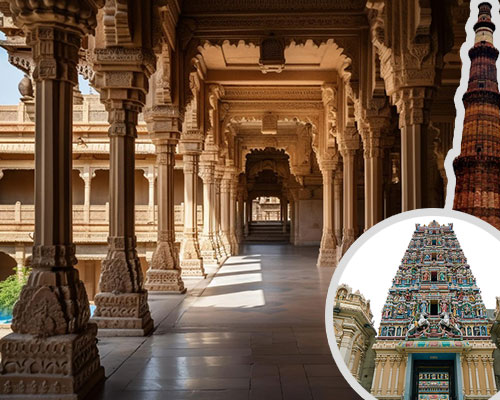
Indian Architecture
Home to one of the Wonders of the World, the Taj Mahal, and approximately 40 world heritage sites, the picturesque architecture is an impeccable element of Indian culture. Be it majestic monuments, caves or sculptured temples, mosques or churches, all of these show the engineering and artistic brilliance of India. Indian architecture is characterised by diversity, visually appealing carvings, intricate details and technically-backed artistry. A few examples of architectural marvels include Tawang Monastery in Arunachal Pradesh (the second largest monastery in the world), Delhi's Qutub Minar, Victoria Memorial in Kolkata, Ajanta & Ellora Caves in Aurangabad, Charminar & Golconda Fort in Hyderabad, etc.

India Gate
India Gate
The India Gate is a war memorial located near the Kartavya path on the eastern edge of the "ceremonial axis" of New Delhi, formerly called Rajpath

Akshardham
Akshardham
Swaminarayan Akshardham is a Hindu temple, and spiritual-cultural campus in Delhi, India. The temple is close to the border with Noida. Also referred to as Akshardham Temple or Akshardham Delhi, the complex displays millennia of traditional and modern Hindu culture, spirituality, and architecture.

Red Fort
Red Fort
The Red Fort or Lal Qila is a historic fort in the Old Delhi neighbourhood of Delhi, India, that historically served as the main residence of the Mughal emperors. Emperor Shah Jahan commissioned construction of the Red Fort on 12ᵗʰ May 1638, when he decided to shift his capital from Agra to Delhi.

Taj Mahal
Taj Mahal
One of the seven wonders of the world, Taj Mahal is located on the banks of River Yamuna in Agra. It was built by the Mughal Emperor Shah Jahan as a memorial for his third wife, Mumtaz Mahal. It also houses the tomb of Shah Jahan himself. Constructed entirely out of white marble in the 17th century, Taj Mahal is one of the most beautiful monuments in the world.

Fatehpur Sikri
Fatehpur Sikri
Located at a distance of 40km from Agra, Fatehpur Sikri is a town in the Agra district and a famous tourist attraction. A city predominantly made of red sandstone, Fatehpur Sikri was founded in 1571 century by Mughal Emperor Akbar. It is essentially a fortified city built by the king and had been the capital of his Empire for fifteen years.
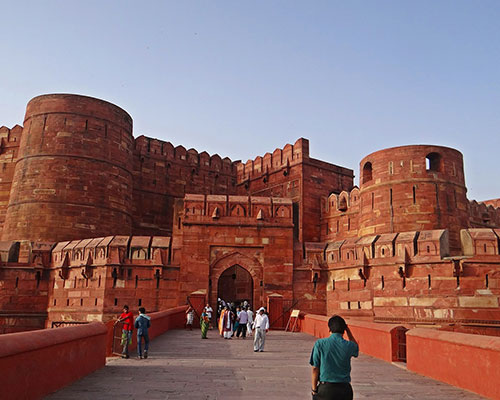
Agra Fort
Agra Fort
An architectural masterpiece, The Red Fort of Agra or Agra Fort was built by Emperor Akbar in 1573. It is located on the right bank of the River Yamuna and is made entirely of red sandstone. The historical fort was once the ersthwhile residence of the Mughals until 1638. One of the UNESCO World Heritage Sites, it lies 2.5 kilometres from Taj Mahal.
Vibrant Dance and Music
Philosophy of 'Vasudhaiva Kutumbakam' and ' Atithi Devo Bhava' are the pivotal cultural values of India. Vasudhaiva Kutumbakam, translating to 'the world is one family' signifies the importance of co-existence, non-violence and holistic development of the world together. Similarly, the concept of 'Atithi Devo Bhava' which translates to 'the guest is like a God', puts emphasis on being hospitable to every person coming to India from outside. The guest-host relationship foretells that the guests are to be embraced with open arms and treated with warmth and friendliness while making them feel at home.

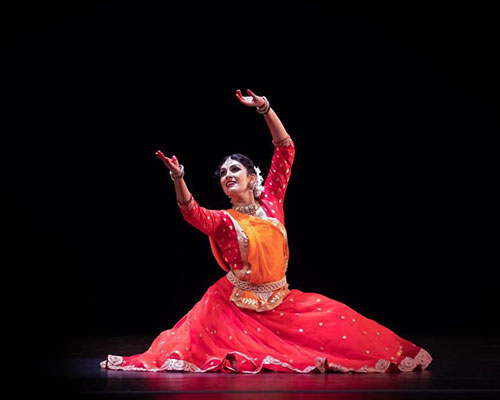
Kathak
Kathak
Kathak is one of the eight major forms of Indian classical dance. It is the classical dance form from Uttar Pradesh. The origin of Kathak is traditionally attributed to the traveling bards in ancient northern India known as Kathakars or storytellers.
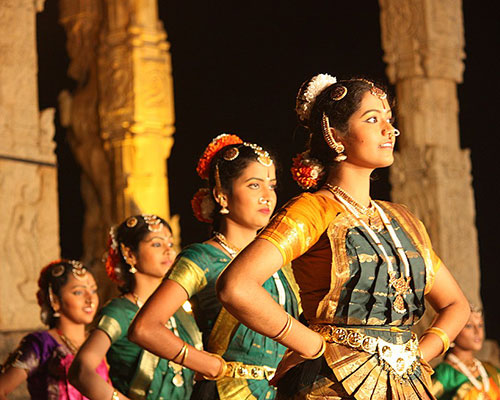
Bharatanatyam
Bharatanatyam
Bharatanatyam is an Indian classical dance form that originated in Tamil Nadu. It is one of eight Indian classical dance forms recognized by the Sangeet Natak Akademi, and expresses South Indian religious themes and spiritual ideas, particularly of Shaivism and in general of Hinduism.

Lavani
Lavani
Lavani is a genre of music popular in Maharashtra, India. Lavani is a combination of traditional song and dance, which particularly performed to the beats of Dholki, a percussion instrument. Lavani is noted for its powerful rhythm. Lavani has contributed substantially to the development of Marathi folk theatre.
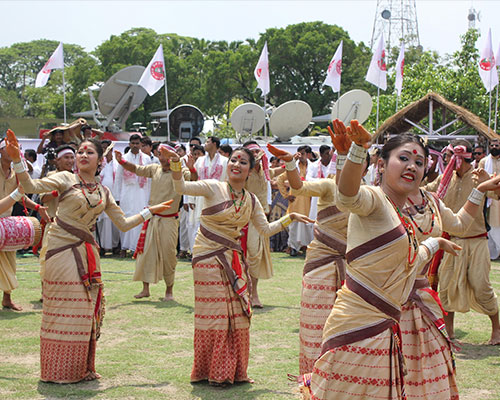
Bihu
Bihu
Bihu is a set of three important cultural festivals unique to the Indian state of Assam – 'Rongali' or 'Bohag Bihu' observed in April, 'Kongali' or 'Kati Bihu' observed in October or November, and 'Bhogali' or 'Magh Bihu' observed in January.
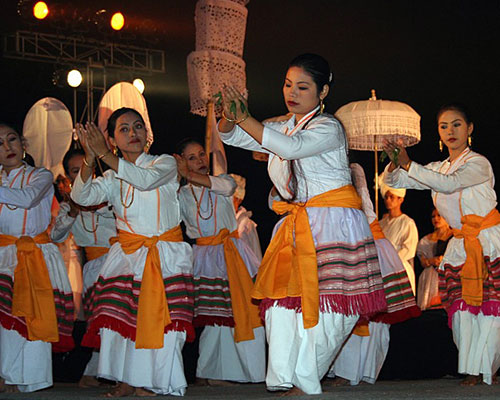
Manipuri
Manipuri
There are many different dance styles from Manipur, a state in northeastern India bordering with Myanmar (Burma), Assam, Nagaland and Mizoram. Manipuri dances encompasses both classical and folk dance forms. The Raas Leela is one of the major Indian classical dance forms.
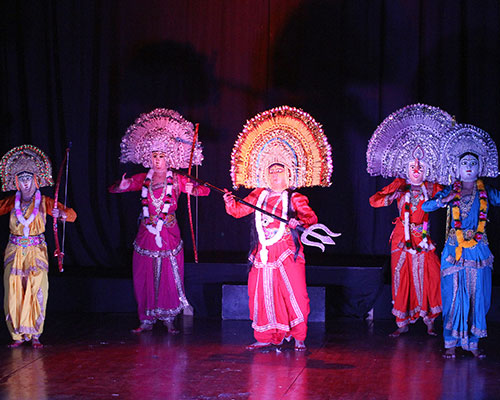
Chhau
Chhau
Chhau dance, also spelled Chhou dance, is a semi classical Indian dance with martial and folk traditions. It is found in three styles named after the location where they are performed, i.e. the Purulia Chhau of West Bengal, the Seraikella Chhau of Jharkhand and the Mayurbhanj Chhau of Odisha.